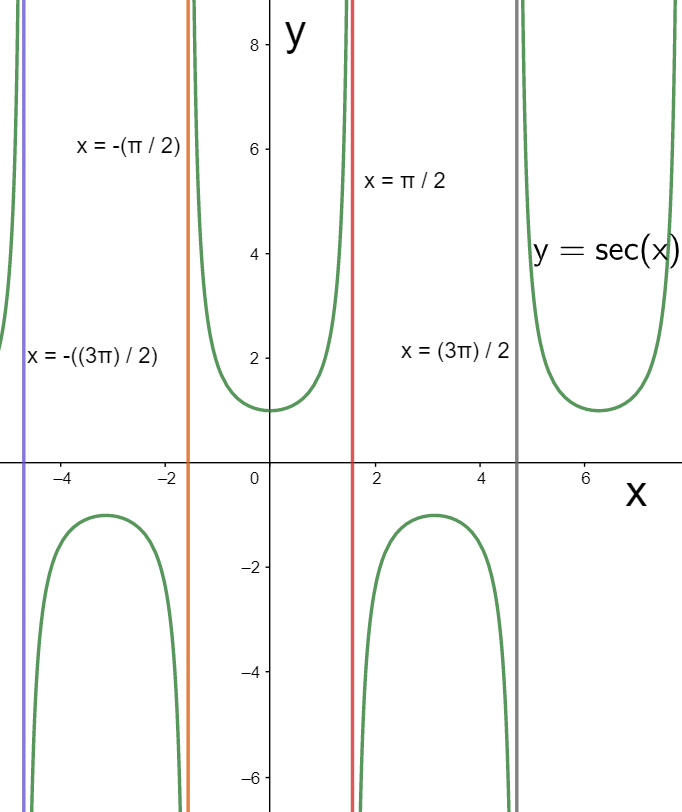
How do you find a vertical asymptote for $y=\sec \left( x \right)$?
Answer
531.6k+ views
Hint: The asymptote of a function is a line to which the graph of the function approaches when one or both of the x and y coordinates approaches infinity. In the above question, we are asked to find the vertical asymptote for the function $y=\sec \left( x \right)$. The vertical asymptote means that only the y coordinate will approach infinity when the x coordinate approaches a finite value. For this we need to determine the value of x for which the function $y=\sec \left( x \right)$ approaches infinity. Since $\cos \left( x \right)=\dfrac{1}{\sec \left( x \right)}$, $\cos \left( x \right)$ will approach zero. From this, all the vertical asymptotes can be determined.
Complete step by step solution:
We know that the asymptote of a function is a line to which the graph of the function approaches when one or both of the x and y coordinate approaches infinity. But since we are asked to determine the vertical asymptote, the y coordinate must tend to infinity for a particular value of the x coordinate. According to the above question $y=\sec \left( x \right)$, which means that $\sec \left( x \right)$ will approach infinity. Also, we know that $\cos \left( x \right)=\dfrac{1}{\sec \left( x \right)}$. So as $\sec \left( x \right)$ will approach infinity, $\cos \left( x \right)$ will approach zero. So we consider the equation
$\Rightarrow \cos \left( x \right)=0$
We know that the general solution of the above equation is given by
$\Rightarrow x=\dfrac{\left( 2n+1 \right)\pi }{2}$
So the vertical asymptotes of the given function are $x=\pm \dfrac{\pi }{2},\pm \dfrac{3\pi }{2},\pm \dfrac{5\pi }{2}......$
We can observe these asymptotes in the below graph.

Hence, we have determined the vertical asymptotes of the given function.
Note: We must note from the above graph of the function $y=\sec \left( x \right)$ that only the vertical asymptotes exist for it. Since the secant function is a trigonometric function, it is periodic and therefore no horizontal asymptote will exist for it. The asymptote of the given function are determined as $x=\pm \dfrac{\pi }{2},\pm \dfrac{3\pi }{2},\pm \dfrac{5\pi }{2}......$. These values can also be termed as the points of discontinuities for the given function, as can be seen in the above graph. Therefore for determining the vertical asymptotes of a trigonometric function, we just have to find out its points of discontinuities.
Complete step by step solution:
We know that the asymptote of a function is a line to which the graph of the function approaches when one or both of the x and y coordinate approaches infinity. But since we are asked to determine the vertical asymptote, the y coordinate must tend to infinity for a particular value of the x coordinate. According to the above question $y=\sec \left( x \right)$, which means that $\sec \left( x \right)$ will approach infinity. Also, we know that $\cos \left( x \right)=\dfrac{1}{\sec \left( x \right)}$. So as $\sec \left( x \right)$ will approach infinity, $\cos \left( x \right)$ will approach zero. So we consider the equation
$\Rightarrow \cos \left( x \right)=0$
We know that the general solution of the above equation is given by
$\Rightarrow x=\dfrac{\left( 2n+1 \right)\pi }{2}$
So the vertical asymptotes of the given function are $x=\pm \dfrac{\pi }{2},\pm \dfrac{3\pi }{2},\pm \dfrac{5\pi }{2}......$
We can observe these asymptotes in the below graph.

Hence, we have determined the vertical asymptotes of the given function.
Note: We must note from the above graph of the function $y=\sec \left( x \right)$ that only the vertical asymptotes exist for it. Since the secant function is a trigonometric function, it is periodic and therefore no horizontal asymptote will exist for it. The asymptote of the given function are determined as $x=\pm \dfrac{\pi }{2},\pm \dfrac{3\pi }{2},\pm \dfrac{5\pi }{2}......$. These values can also be termed as the points of discontinuities for the given function, as can be seen in the above graph. Therefore for determining the vertical asymptotes of a trigonometric function, we just have to find out its points of discontinuities.
Recently Updated Pages
Master Class 12 Business Studies: Engaging Questions & Answers for Success

Master Class 12 Economics: Engaging Questions & Answers for Success

Master Class 12 English: Engaging Questions & Answers for Success

Master Class 12 Maths: Engaging Questions & Answers for Success

Master Class 12 Social Science: Engaging Questions & Answers for Success

Master Class 12 Chemistry: Engaging Questions & Answers for Success

Trending doubts
What is meant by exothermic and endothermic reactions class 11 chemistry CBSE

Which animal has three hearts class 11 biology CBSE

10 examples of friction in our daily life

One Metric ton is equal to kg A 10000 B 1000 C 100 class 11 physics CBSE

1 Quintal is equal to a 110 kg b 10 kg c 100kg d 1000 class 11 physics CBSE

Difference Between Prokaryotic Cells and Eukaryotic Cells




